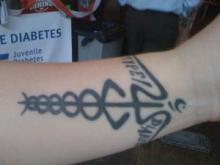Those were among the questions raised by Dr. Saleh Aldasouqi in a poster presentation and at a press briefing at the annual meeting of the American Association of Clinical Endocrinologists.
Some patients with diabetes and other hidden medical conditions are choosing to be permanently tattooed rather than wear a necklace or bracelet to alert emergency personnel of their conditions. This is particularly common among patients with type 1 diabetes, for whom low blood sugar can result in unconsciousness or odd behavior that can easily be mistaken for drunkenness.
“There are a lot of patients with diabetes who are getting tattoos. Just Google ‘medical tattoos’ or ‘diabetic tattoos’ and you’ll find a large number from around the world. The problem is they’re not consulting their physicians. They could have high sugar, which can affect wound healing. …There are so many issues now being talked about with regard to medical tattooing,” noted Dr. Aldasouqi, an endocrinologist at Michigan State University, Lansing.
He believes these issues should be addressed by professional medical organizations, possibly including those pertaining to diabetes, dermatology, and emergency medicine.
As for tattoo location on the body, the wrist would be the most logical place since first responders will always check there, he said.
So who should do the tattooing? Tattoo parlors that are licensed under state or local laws are typically clean and use sterile equipment, and require customers to read and sign consent forms that address medical conditions and risks. Of course, tattoo artists would need to be educated about any new standard.
But dermatologists or plastic surgeons could do it as well. “We’re not competing with tattoo artists, but at least we can collaborate with them by standardizing at their level, or make it a minor surgical procedure. In fact, this is being done to mark the skin for radiation therapy in cancer patients, and in reconstructive surgery after breast cancer. Some medical tattooing is already being done by medical specialists. So, it’s open for discussion.”
-Miriam E. Tucker (@MiriamETucker on Twitter)


